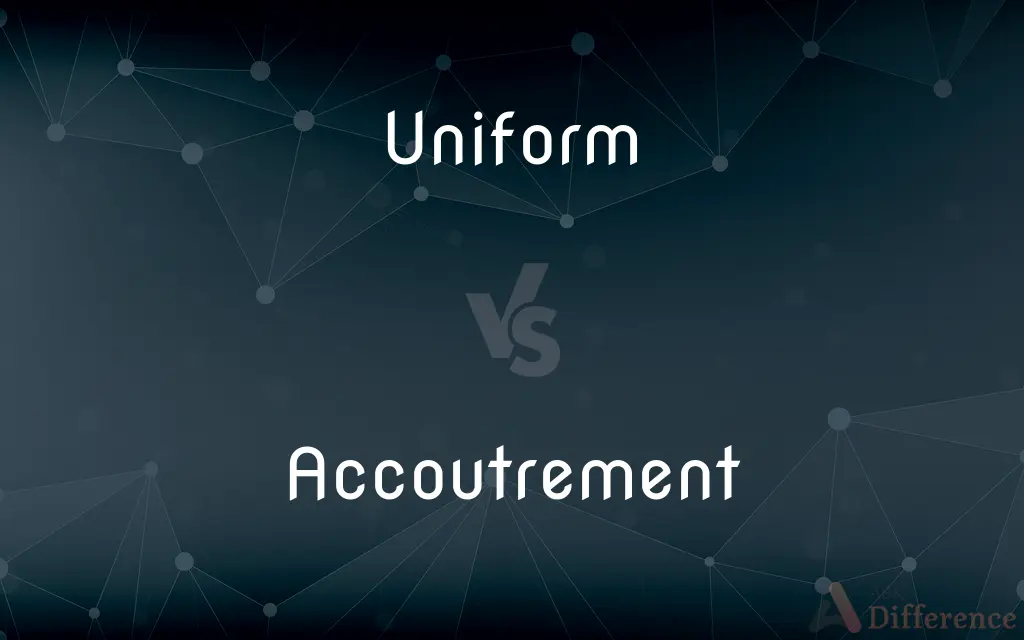Uniform vs. Accoutrement — What's the Difference?
By Tayyaba Rehman & Maham Liaqat — Updated on April 3, 2024
A uniform denotes standardized clothing worn by members of an organization, while accoutrement refers to additional equipment or accessories.

Difference Between Uniform and Accoutrement
Table of Contents
ADVERTISEMENT
Key Differences
Uniforms are standardized sets of clothing worn by members of specific organizations, such as military personnel, school students, or team members, to denote identity and unity. Accoutrement, on the other hand, encompasses the additional items or accessories that are worn or used by individuals, often as part of their uniform, but can also extend to any supplementary equipment.
While uniforms are primarily about creating a cohesive and standardized appearance, accoutrements add a layer of functionality or personalization to an individual's outfit. For example, a police officer's uniform makes them identifiable as law enforcement, whereas their accoutrements, such as a badge, radio, or handcuffs, equip them for their specific duties. This distinction highlights the role of uniforms in establishing identity and accoutrements in enhancing the capabilities or roles of individuals within a group.
Both uniforms and accoutrements play crucial roles in various fields, including the military, emergency services, and corporate environments. Uniforms provide a sense of unity and equality among members, reinforcing the collective identity and standards of the group. Accoutrements, by enhancing functionality or signifying specific roles and achievements, allow for individual responsibilities and achievements to be recognized within the framework of a uniform appearance.
In terms of customization and regulation, uniforms are typically subject to strict standards and regulations to ensure consistency, whereas accoutrements may offer some degree of personalization or variation based on role, rank, or individual needs. This allows organizations to maintain a standardized appearance while also accommodating the specific requirements or distinctions of various roles within the group.
Comparison Chart
Definition
Standardized clothing for organization members
Additional equipment or accessories
ADVERTISEMENT
Primary Purpose
Denote identity and unity
Enhance functionality or denote specific roles
Example Usage
Military uniforms, school uniforms
Belts, badges, weaponry
Symbolism
Authority, professionalism, belonging
Role specificity, individual achievement
Customization
Limited, to maintain standardization
Varies, can be personalized based on role
Contexts
Military, schools, corporate
Military, law enforcement, various professions
Regulation
Strict, to ensure consistency
Less strict, adaptable to needs
Role in Identity
Establishes group identity
Highlights individual roles within a group
Functionality
Primarily aesthetic or symbolic
Practical, enhances role capabilities
Compare with Definitions
Uniform
Can signify rank or role.
The stripes on his uniform indicated his rank as a sergeant.
Accoutrement
Signifies specific responsibilities.
The detective's badge, an important accoutrement, signifies her authority.
Uniform
Represents unity and belonging.
School uniforms are intended to promote a sense of community among students.
Accoutrement
Varies across professions.
A mountaineer's accoutrements might include ropes, carabiners, and harnesses.
Uniform
Standardized clothing for group identification.
The new recruits were issued their military uniforms during orientation.
Accoutrement
Enhances functionality of a uniform.
A soldier's accoutrements, like ammunition pouches, are essential for their duties.
Uniform
Subject to strict regulations.
Airline pilots must adhere to uniform standards that include caps and epaulets.
Accoutrement
Supplementary equipment or accessories.
The firefighter's accoutrements included an axe and a safety helmet.
Uniform
Often required by professions.
Nurses wear uniforms for easy identification and hygiene.
Accoutrement
Can be personalized based on role.
The chef's accoutrements included a personalized apron and a set of knives.
Uniform
A uniform is a type of clothing worn by members of an organization while participating in that organization's activity. Modern uniforms are most often worn by armed forces and paramilitary organizations such as police, emergency services, security guards, in some workplaces and schools and by inmates in prisons.
Accoutrement
An additional item of dress or equipment
The accoutrements of religious ritual
Uniform
Always the same, as in character or degree; unvarying
Planks of uniform length.
Accoutrement
Often accoutrements An accessory item of equipment or dress.
Uniform
Being the same as or consonant with another or others
Rows of uniform brick houses.
Accoutrement
Often accoutrements Military equipment other than uniforms and weapons.
Uniform
A distinctive set of clothing intended to identify the members of a specific group
A police uniform.
Accoutrement
Accoutrements Outward forms of recognition; trappings
Cathedral ceilings, heated swimming pools, and other accoutrements signaling great wealth.
Uniform
To make (something) uniform.
Accoutrement
(Archaic)The act of accoutring.
Uniform
To provide or dress with a uniform.
Accoutrement
(Commonwealth) accouterment
Uniform
Unvarying; all the same.
Accoutrement
An item of clothing that is worn or carried, but not part of one's main clothing.
Uniform
Consistent; conforming to one standard.
Accoutrement
Clothing that is worn or carried, but not part of your main clothing
Uniform
(mathematics) with speed of convergence not depending on choice of function argument; as in uniform continuity, uniform convergence
Uniform
Composed of a single macromolecular species.
Uniform
(geometry) (of a polyhedron) That is isogonal and whose faces are regular polygons; (of an n-dimensional (n>3) polytope) that is isogonal and whose bounding (n-1)-dimensional facets are uniform polytopes.
Uniform
A distinctive outfit that serves to identify members of a group.
Uniform
(international standards) nodot=1 NATO/ICAO Phonetic Alphabet.}}
Uniform
(police) A uniformed police officer (as opposed to a detective).
Uniform
(transitive) To clothe in a uniform.
Uniform
Having always the same form, manner, or degree; not varying or variable; unchanging; consistent; equable; homogenous; as, the dress of the Asiatics has been uniform from early ages; the temperature is uniform; a stratum of uniform clay.
Uniform
Of the same form with others; agreeing with each other; conforming to one rule or mode; consonant.
The only doubt is . . . how far churches are bound to be uniform in their ceremonies.
Uniform
A dress of a particular style or fashion worn by persons in the same service or order by means of which they have a distinctive appearance; as, the uniform of the artillery, of the police, of the Freemasons, etc.
There are many things which, a soldier will do in his plain clothes which he scorns to do in his uniform.
Uniform
To clothe with a uniform; as, to uniform a company of soldiers.
Uniform
To make conformable.
Uniform
Clothing of distinctive design worn by members of a particular group as a means of identification
Uniform
Provide with uniforms;
The guards were uniformed
Uniform
Always the same; showing a single form or character in all occurrences;
A street of uniform tall white buildings
Uniform
The same throughout in structure or composition;
Bituminous coal is often treated as a consistent and homogeneous product
Uniform
Not differentiated
Uniform
Evenly spaced;
At regular (or uniform) intervals
Common Curiosities
Why might an individual's accoutrements vary within the same organization?
Accoutrements may vary based on the individual's specific role, rank, or personal needs, allowing for some degree of personalization within a standardized framework.
Can accoutrements be part of a uniform?
Yes, accoutrements can complement a uniform by adding functionality or indicating the wearer’s specific role or achievements.
How are uniforms regulated?
Uniforms are subject to strict regulations and standards to ensure consistency and adherence to the organization's identity.
What role do accoutrements play in the military?
In the military, accoutrements include items like badges, insignia, and weaponry, which enhance functionality and denote rank or achievements.
Can the design of a uniform affect its functionality?
Yes, the design and material of a uniform can impact its functionality, comfort, and suitability for specific tasks or environments.
Is there a cultural significance to certain accoutrements?
Yes, certain accoutrements can carry cultural or historical significance, representing traditions or values of the organization or community.
What is the primary purpose of a uniform?
To create a standardized appearance that signifies membership and unity within an organization.
Can wearing a uniform affect an individual's behavior?
Studies suggest that wearing a uniform can influence behavior, promoting a sense of responsibility and alignment with the organization’s values.
What does accoutrement mean?
Accoutrement refers to additional items or accessories worn or used by an individual, often to enhance functionality or denote specific roles.
Are uniforms only used by military and law enforcement?
No, uniforms are used in various settings including schools, corporations, and sports teams, anywhere that identity and unity are important.
Do uniforms evolve over time?
Yes, uniforms can evolve in response to changes in fashion, technology, and the practical needs of the organization.
What's the difference between personal clothing and uniform?
Personal clothing is chosen by the individual for personal expression, while a uniform is mandated by an organization for consistency.
How are accoutrements selected for a specific role?
Accoutrements are selected based on the specific needs, functionality, and responsibilities associated with a role.
How does uniform standardization impact an organization?
Standardization reinforces a collective identity, promotes equality among members, and can enhance professionalism and discipline.
Why might an organization choose to update its uniform or accoutrements?
Updates may be made to improve functionality, reflect changes in identity or branding, or accommodate advancements in materials and technology.
Share Your Discovery

Previous Comparison
Gank vs. Gang
Next Comparison
Inquietude vs. DisquietAuthor Spotlight
Written by
Tayyaba RehmanTayyaba Rehman is a distinguished writer, currently serving as a primary contributor to askdifference.com. As a researcher in semantics and etymology, Tayyaba's passion for the complexity of languages and their distinctions has found a perfect home on the platform. Tayyaba delves into the intricacies of language, distinguishing between commonly confused words and phrases, thereby providing clarity for readers worldwide.
Co-written by
Maham Liaqat















































